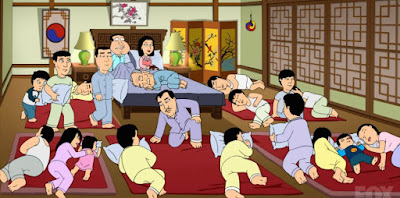The 63 Building:
Namsan Tower:
And Jogyesa:
A subplot of the episode is Lisa's sudden desire to go to Korea too to go to Jogyesa because of their amazing sand mandalas. I was fairly certain that was not a thing you'd expect to find at Jogyesa, so it was nice to see David Mason confirm that.
The esports tournament takes place at what appears to be World Cup Stadium, and when things go awry this robot appears:
Considering Korea's plans to replace foreign English teachers with robots (one of the best inventions of 2010, said Time Magazine), this made me smile a little, but I'd imagine that's not what the writers were thinking of.

The reference below is to the fact that The Simpsons is animated in Korea.
As I noted in the article, "The Simpsons Animation and Casino is a rather lame joke, but recalls the 1992 episode Itchy & Scratchy: The Movie, where a news program reviewed the history of the animation Itchy & Scratchy and showed the studio where it was made in South Korea, which featured soldiers with bayonet-fixed rifles prodded animators in the back to make them work faster, a scene which angered The Simpson's Korean animators." Here's the scene from that episode:
The arrival of riot police at the end of the episode almost seems like a modern update to the above image, particularly considering Koreans tend not to riot at sports events.
As I noted in the article, the entire appearance of Seoul in the episode just felt shoehorned in. There's really no engagement with the place at all. It could have been anywhere.
For a far-more-engaged episode of TV, 10th episode of Family Guy's 14th season, "Candy, Quahog Marshmallow," which aired three years ago, was about a trip to Seoul taken after it's discovered the character Quagmire was once a Korean soap star. The plot can be found here:
Compared to the nondescript city scenes in The Simpsons, the following establishing shots are clearly recognizable as Seoul, Busan, Incheon Airport (despite the name change) and Gwanghwamun Plaza:
Unlike The Simpsons, there are no English language jokes shoehorned into the street scenes.
And despite that not being a makgeolli bottle, there's quite a bit of detail put into the restaurant shots...
... particularly with the walls (the beer ad is spot on):
There's a certain amount of engagement with the culture, beginning with the TV dramas which bring them to Seoul in the first place (to find the last episode of the series they were watching that their friend starred in):
The main character gets some plastic surgery done:
They watch Sistar's "Touch My Body" and are quite enamoured with Kpop for some reason.
Then they make their own Kpop video, which, while pretty dumb, is still a serviceable parody and shows a level of engagement with the actual culture, unlike The Simpsons.
There are some duds, of course. Quagmire reunites with his former costar and rekindles their romance, but decides to leave when he finds out the entire extended family lives with them. Needless to say, you'd be very, very hard-pressed to find such a thing in Seoul.
The less said about Ashton Kutcher's Pet Engine Cooking Bag ad (so you can cook dogs under the hood while you drive), the better, but there is a level of detail here that balances it out a bit (the dog on the box saying "맛있는!" and the 1000 won 할인).
And, unlike The Simpsons, there may be a joke here few would get: The bus that runs down the character in the TV drama is #588. I've read that in decades past the route for bus 588 took it past the Cheongnyangni red light district, which inspired its nickname, '588.'
It's easy enough to see, despite some cluelessness and a dog meat joke, that Family Guy engaged with Korea far more than The Simpsons, and I say this as someone who has never liked Family Guy. Those interested in the decline of the once-great Simpsons are recommended to watch the Youtube video "The Fall of The Simpsons: How it Happened."























